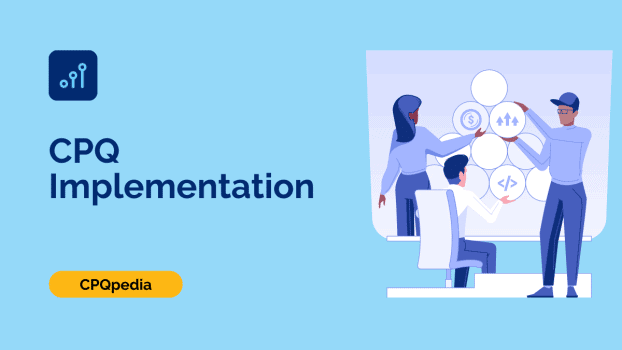What is CPQ Implementation?
CPQ implementation is the start-to-finish process of setting up CPQ software in an organization. It includes all aspects of installation, configuration, testing, and user training.
Activities associated with CPQ implementation include:
- Setting up CPQ product rules to automate product configuration
- Integrating CPQ with other business systems, such as CRM and ERP
- Correctly configuring the user interface for each user type
- Creating pricing models and discounting rules
- Testing CPQ functionalities in real-world scenarios
- Training users on the features of the system
Usually, the CPQ vendor will carry out the implementation process — though in some cases, the customer may be responsible for certain tasks to ensure full integration with their existing systems.
For instance, a vendor can carry out custom coding and CRM integrations, but the customer is responsible for providing access to APIs and necessary credentials.
Synonyms
- CPQ software implementation
- CPQ implementation support
Benefits of Successful CPQ Implementation
A successful CPQ implementation saves time, reduces costs, increases organizational efficiency, improves customer satisfaction by driving user adoption, and ultimately drives greater profits.
Greater Quote Accuracy
Inaccurate sales quotes are one of the main issues that CPQ software fixes, but it is only effective in doing so if it is properly implemented. In a successful CPQ implementation, quotes are accurate and consistent since product models and pricing rules are automated.
To ensure quote accuracy post-implementation, the purchasing company must provide their vendor with accurate product data. This includes:
- Pricing information
- Product availability
- Discounts and promotions
- Complementary products and services
- Add-ons and customizations
Once the product data is provided, then the vendor can create CPQ rules that ensure pricing accuracy and consistency.
Fewer Quote Revisions
Pricing mistakes are a nightmare for sellers — they ruin the customer experience and impact sales performance, margins, and company reputation. They typically occur because companies change their pricing rules too frequently, which makes them difficult to track.
Rogue pricing (another major cause of pricing errors) happens when sales representatives change their prices in the hopes of closing deal.
CPQ software prevents rogue pricing by allowing sellers to preconfigure rules for how much they can discount, which can’t be changed without authorization. It centralizes pricing rules and provides immediate access to up-to-date pricing information.
During implementation, setting up automated approval workflows takes this one step further by ensuring quotes have been reviewed and authorized before they are sent out.
Higher Sales Efficiency
Sales efficiency is largely based on a sales team’s ability to quote their prospects quickly, accurately, and professionally. Sales reps only spend about one-third of their time selling, while most of their day is spent on administrative tasks, prospecting, and data entry.
When done properly, CPQ implementation automates email follow-ups, document generation, approval workflows, and contracting processes to minimize inefficiencies and reduce time-to-close.
Reduced Costs
Between the cost of mistakes, lost sales, and time wasted on manual processes, sales is a costly endeavor. Although CPQ implementation itself entails some costs (and potential downtime), the long-term cost savings from process automation are well worth it.
By eliminating the need for back-and-forth emails, manual data entry in the company’s CRM software, and document generation, CPQ software reduces costs on the administrative side while producing greater cost savings through accurate quotes, speed, and a better customer experience.
Shortened Sales Cycle
Practically every benefit of a successful CPQ implementation entails a faster sales cycle. Every feature CPQ software provides contributes to a shorter sales cycle length (which typically lasts over two months) in one way or another.
For example:
- Quote templates eliminate the need for sellers to start from scratch every time they generate a quote.
- Approval workflows prevent backtracking further down the line by letting company leadership authorize quotes before they’re sent to prospects.
- Automatic document generation means NDAs, contracts, and presentations won’t take hours or days to produce.
- Contract lifecycle management accelerates negotiations, makes it easier for sellers to maintain a solid relationship with their buyers, and streamlines the contract renewal process.
- Integrations with CRM and ERP systems speed up lead qualification, tracking, and reporting while centralizing data.
- Visual product configurators make it easier for sellers and buyers to understand each other, especially in the case of complex product configurations.
- Product bundles eliminate manual product selection in the quote generation process for common deals.
Synchronized Data
According to Forrester and Dell Technologies’ Data Paradox study, 60% of business leaders responsible for data in their respective organizations describe silos as the biggest challenge to delivering on data’s promise.
A successful CPQ implementation reduces the risk of silos by centralizing product information and customer data in one place. It automatically synchronizes pricing, discounts, and configurations with each customer’s requirements, eliminating the need for manual tracking of changes and updates.
It considers the entire product catalog, connecting certain customer segments to specific product bundles, configurations, or pricing models that the seller manually pre-set.
Better Reporting
Leaders, executives, and investors rely on sales data to understand company financial health and make decisions about where to invest in additional resources or make cuts.
The continuous data flow between CPQ and other sales tools helps analytics tools and data teams produce more accurate projections and insights.
Using the data gathered from CPQ can also help companies identify underperforming sales reps, create targeted training programs to improve their performance, and more accurately predict revenue growth.
CPQ Implementation Steps
To realize the above benefits, a company needs to do the CPQ implementation process right. These are the steps it takes to get there:
Set Project Goals
Before anything, it’s important to determine the specific goals for CPQ implementation. Ideally, those involved in the sales process will have already identified and recorded some of the issues they are trying to solve.
Aside from company problems, other goals of CPQ implementation include:
- Companywide adoption of new CPQ system
- Integration with the existing tech stack
- Deciding on pricing rules and modifications to include
- Defining and integrating approval workflows
- Data consolidation through centralization
- Navigating potential downtime
- Technical considerations
Before proceeding with CPQ implementation, everyone in the company will have to be on the same page, from the bottom up.
Gather Sales Team Needs
Getting everyone on the same page starts with the sales team (who will primarily interact with the system).
The “sales team” includes:
- All sales reps, AEs, and account managers
- Sales ops
- Sales leaders and executives
- Customer success representatives
During this step, members of the sales team will prioritize their needs and preferences. They will also identify relevant processes and specify where automation fits into the picture.
Understand Customers’ Needs
To improve the closure and contract renewal rate with CPQ, they need to understand how exactly it will benefit their customers.
This includes researching their buyer personas and understanding how they research, shop, and buy. It’s also important to consider the customer journey — from product discovery to negotiation to post-sale support — and how CPQ can automate it (e.g., by setting up guided selling workflows).
Plan the Implementation Project
After laying the groundwork and defining the CPQ process, an organization can begin to plan the project.
This is when they will map out the implementation timeline, decide on an internal or external team for deployment and support, and build a budget.
The above considerations all vary depending on how large the company is and how complex its products are. Enterprise sales organizations will have considerably longer implementation times and higher costs than SMBs.
Determine the Necessary Features
Especially if an organization requires customizations, it is essential to have a comprehensive understanding of the features they need and how they will use them.
Common features include:
- Product catalogs and dynamic product configurations
- Guided selling workflows
- Quote templates
- Approval workflows and rules-based accessibility
- Detailed analytics and reporting capabilities
- Document generation, management, and e-signature
But many companies need to extent the feature set of their CPQ software to fit their specific needs. This could include third-party integrations, custom coding (APIs), or even AI and ML algorithms.
Select Your Project Management Team
Every implementation process needs a project management team to carry it out. Depending on the company size and how many people are working on the project, it could be as small as two or three people (e.g., an executive sponsor, implementation lead, and lead engineer) or a few dozen people from various departments.
Regardless of the size, they should all understand their roles and responsibilities. In general, the project manager is responsible for the project’s timeline, resources, and budget, while the executive sponsor is responsible for making decisions and driving progress.
Other implementation team members — engineers, analysts, and developers — fill in the technical gaps.
Configure CPQ With Your Products, Pricing, and Discounting Rules
Once the CPQ implementation team is in place, they can begin configuring the software with your organization’s specific information and rules.
Products, pricing, discounts, and other configurations must all be set up for CPQ to work properly.
Most CPQ software makes this easy — with wizards, templates, and drag-and-drop features, even beginners can get up and running quickly.
The most important consideration during this step is that everyone agrees with pricing and discounting rules before moving on.
Synchronize Data Across Platforms
If the data flow stops at any point, CPQ becomes a bottleneck. Every company has a different tech stack, but the general flow of data from CPQ is as follows:
- Product information data syncs from the underlying systems to CPQ
- Configured products in CPQ are routed to customers with quotes and orders
- Once accepted, data is sent back to the ERP or CRM system
- Data is then passed on to analytics tools, billing systems, and other third-party applications (if necessary)
Companies using sales enablement tools, ecommerce platforms, marketing automation systems, and customer success software will also need to integrate those.
FAQs
A CPQ implementation can take anywhere from weeks to months to complete. There is no standard amount of time for a CPQ implementation — it varies wildly depending on company requirements, organization size and structure, technical capabilities, and countless other factors.
There are four main types of product rules in CPQ:
Validation: Confirms that products, options, and pricing match predetermined conditions
Alert: Trigger notifications when there is a potential problem with configuration or pricing
Filter: Pre-filter products available to add to a bundle
Selection: Automatically add, remove, or adjust product configurations and pricing in a bundle

Andrew is a professional copywriter with expertise in creating content focused on business-to-business (B2B) software. He conducts research and produces articles that provide valuable insights and information to his readers.

